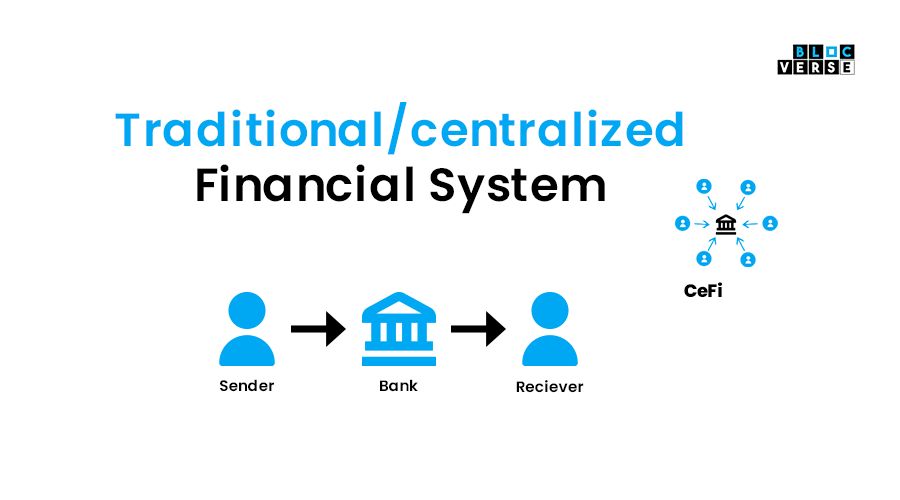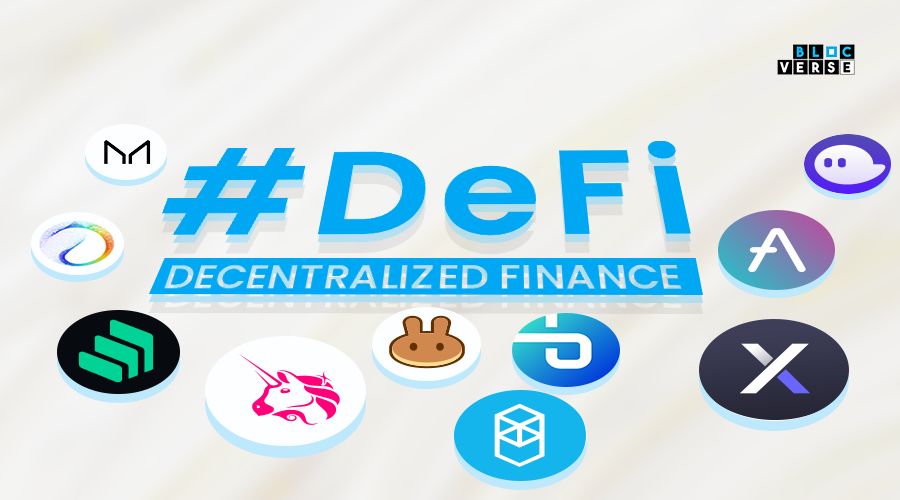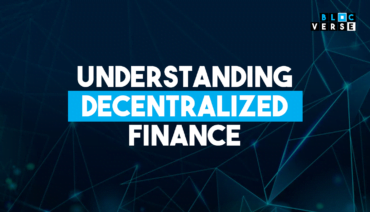Years back, people traded goods and services for other goods and services.
But, as humans developed, the economy developed.
We invented the “currency” to make it easier to exchange goods and services.
Subsequently, coins helped usher in innovations and created better levels of the economy.
A little about Centralized Finance (CeFi)

Today, almost all of our financial systems and the services they provide run on centralized networking.
Examples of these centralized systems include banks, the stock exchange, insurance companies, and other financial institutions.
These financial institutions have someone or an organization in charge/control of how they deliver their services.
And these centralized entities bring with them several risks/flaws, such as mismanagement, fraud, and corruption, to name a few.
Traditional/centralized financial services such as payments, loans, and borrowing were only available through existing financial systems and banks before Defi.
Historically, the central government has produced currencies that support our economy, giving them increasing authority as more people come to trust them.
However, we see an occasional breach in confidence that has led many to question the centralized authority’s competence in handling our money.
Thus, things changed with the inception of blockchain technology.
Decentralized finance (DeFi) developed a financial system that is accessible to everyone and reduces the need to trust and rely on a central authority.
Understanding Decentralized Finance and its ecosystem.

Before DeFi, we relied on centralized bodies like the bank to keep our money, execute transactions, and so on.
We often trust that these centralized bodies will not act in an unjust/biased way.
By the end of the day, we keep getting disappointed as the latter is usually the case.
DeFi has created a decentralized world on the blockchain that keeps you in charge of your finance, anytime, anywhere in the world.
What is DeFi?
Decentralized finance is an umbrella name for a multitude of public blockchain apps and initiatives that aim to eliminate the traditional/centralized financial industry.
DeFi is a financial application built on blockchain technology that uses smart contracts to execute transactions.
It provides a unique experience compared to traditional banking and opens up a world of opportunities/possibilities for users.
This fantastic system developed a financial system that is accessible to anyone and reduces the need to trust and rely on a single authority.
Why use Decentralized Finance?
1. It is Permissionless
Users do not require permission to use DeFi because it operates on public blockchains, and public blockchains are permissionless blockchains.
Unlike centralized finance, where consumers must undergo a KYC procedure to use specific services, which may include disclosing personal information.
Developers who want to build on permissionless blockchains may do so freely, making it extremely accessible.
2. DeFi is Trustless
One big advantage of using DeFi services is that they are completely trustworthy.
Its users ensure DeFi services work as expected by inspecting their code.
DeFi services are transparent because of smart contracts (lines of codes) that govern them, making them more reliable than human beings.
Here, you do not have to trust an intermediary (centralized body) because you’re solely responsible and in charge of your finance.
Actions performed using DeFi systems are programmable, and their execution on the Blockchain uses smart contracts.
3. Transparency
DeFi offers transparency. As it functions on blockchain technology, all transactions, data, and codes on the blockchain are transparent to everyone.
With DeFi, you can track and carry out transactions transparently on the blockchain.
Public blockchains are entirely open-source software, i.e. anyone and everyone can view its code and fork it.
Also, when carrying out transactions, it uses the DLT (Distributed Ledger Technology) to display the executed transactions to both parties.
This means a single source cannot control everything. It is all decentralized.
4. Speed
With DeFi, you can do most of the things that banks support like earn interest, lend and borrow loans, buy insurance, trade derivatives, trade assets, and more, as it’s faster and doesn’t require paperwork or a third party.
The DeFi system carries out transactions with ease/instantly, without delay.
Using DeFi lending and borrowing protocols, you can deposit collateral and get your funds in no time, skipping all the processes and protocols that you might encounter using a centralized service.
DeFi protocols

DeFi is developing into a full ecosystem of apps and protocols that provide value to consumers.
In this section, we’ll look at two of these protocols.
1.DeFi lending and borrowing protocol.
By introducing lending and borrowing, DeFi has moved finance in a new direction.
We regard it as “Open Finance”.
Just like centralized bodies or a personal individual lends fiat currency (money) as an investment to a fellow individual or an organization in need of payback with an added interest, DeFi has projects designed to carry out this function
Decentralized lending provided crypto projects/holders with lending options to generate yearly returns.
Decentralized borrowing allows individuals to borrow money at a fixed interest rate for a down payment.
Some DeFi lending and borrowing platforms include Compound Finance and Aave.
2. Decentralized exchanges.
Decentralized Exchanges (DEXs) address the faults in centralized exchanges (CEXs).
The Centralized exchanges (CEXs) provide similar options and investments, subject to the will and expenses of the exchange.
However, DEXs are an important part of DeFi as they allow users to exchange/swap tokens for other assets.
Another disadvantage of CEXs that DEXs address is the additional cost of each transaction.
Some DEX platforms include Uniswap and dydx.
DeFi, The future of Finance.
DeFi is a global financial system built on the blockchain.
Since the start of bitcoin in January 2009, it gave rise to this great technology called “blockchain technology”.
DeFi exists on this technology and inherits its ever-growing features.
Every day, new ideas and products are in constant design and implementation, all to make it scale.
With this technology, you’ll come to understand that “for every problem, there’s an innovation”.
This system disrupted the financial system by solving problems, challenges, and inconsistencies in centralized finance.
We have seen real-world use cases/utilities implemented on the blockchain more efficiently.
Everyone is welcome to take part in the governance of DeFi protocols.
With this system, you have a seat at the table where the world of decentralized finance is actively being formed.
This financial system is progressively catching up with the traditional financial system.
Although, some challenges come with operating on the groundbreaking innovation.
The world of decentralized finance is on the rise and, with everything being said, daily centralization is slowly losing its grip as a new era of decentralization is born.


[…] and most established intelligent contract platform and is home to all things decentralized finance (Defi). It has existed since July […]
[…] All DeFi transactions are stored on a distributed ledger in every instance (distributed ledger). […]